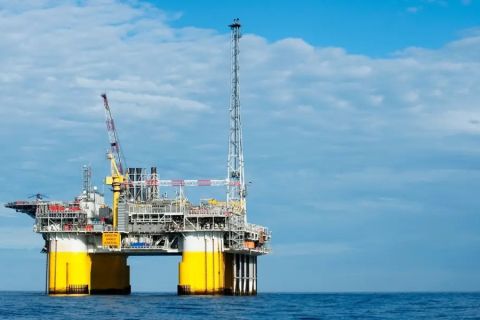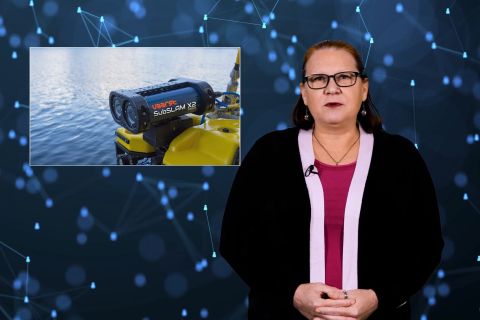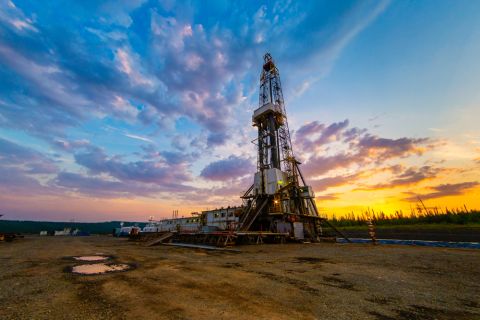
For Chevron’s Epifani, she said she views ESG as a “long-term paradigm that’s always focused on constant improvement.” (Source: Hart Energy; Chevron logo sign by Sasima / Shutterstock.com)
DALLAS—Amid pressure to grow production to meet today’s oil and gas needs while focusing on emissions reduction targets and addressing ESG concerns, traditional oil companies like Chevron Corp. aim to find balance.
This comes as many companies move toward different business models, responding to evolving investor expectations and need to address climate change. For Lisa Epifani, manager of ESG and sustainability for Chevron Corp., companies can either replace oil molecules with electrons, shrink their footprints or remove carbon from the air.
“Some companies are choosing to shrink their business by replacing the oil molecule with electrons. That’s not what Chevron is pursuing,” she told a roomful of people gathered for Hart Energy’s Energy ESG Conference on April 27. “We believe that our assets, our capabilities and our partnerships are best focused on trying to reach reductions in the hard to abate sectors. So, we’re very focused on that reduce and remove part of the formula.”
Chevron, which is targeting net-zero Scope 1 and Scope 2 emissions by 2050, has allocated $10 billion toward advancing its low-carbon future. Of that, $8 billion is allocated for low-carbon investments and $2 billion toward carbon-reduction projects by 2028. Its low-carbon business projects are focused on renewable fuels, hydrogen, offsets and carbon capture.
“We’ve set a target of 25 million tonnes a year of CCUS storage by 2030, and this is a very ambitious target. If you think about the fact that Chevron today operates one of the largest CCS facilities in the world at Gorgon in Australia, that puts about 4 million tonnes a year away,” Epifani said. “We’re trying to build four to five Gorgon-sized CCS over the next 10 years. It’s not going to be a giant one-sized facility, but a lot of storage hubs and networks and partnerships. It’s going to take a lot of work. So, collaboration will be key.”

Energy companies are evolving as the world moves further into the energy transition seeking low-carbon energy sources to minimize the impacts of climate change. The transition, however, must be orderly, Epifani said. Reality should not be overlooked.
She recalled a challenging conversation with some investors who she said wanted Chevron to use the International Energy Agency’s (IEA) net-zero scenario as the company’s business plan.
“We use it as a stress test and offer scenario analysis … but it’s not the basis of our business planning,” Epifani said, calling the IEA’s assumptions lofty. “We don’t see them unfolding today. The world governments are not moving fast enough to put carbon prices in place. Governments are not offering the technology innovation, subsidies and support and so on. So, it’s very important for people, again, to be realistic about the ambition versus the reality.”
More people recognize that the energy transition must make sense for customers, she added, and when that doesn’t happen, supply and demand disruptions occur and customers suffer. “We want to ensure that we have both a plan for ESG but also a plan for energy security and the two have to be balanced.”
There has also been more recognition of the continued need for reliable and affordable energy, Epifani added, pointing to the crisis in Ukraine as evidence. The oil and gas industry has always provided long-term value and it needs to continue doing so, she said, as well as maintaining financial and climate discipline, improving performance and being transparent.
Still, ESG is not going away, she continued. “You'll see customers asking for more information related to the carbon intensity of the products, looking for a responsibly sourced gas. For me, I think of ESG as a long-term paradigm that’s always focused on constant improvement.”
Chevron’s ESG strategy is centered on three pillars, she explained, protecting the environment, empowering people and getting results the right way. “We focus on lowering the carbon intensity of our assets in the most cost-efficient manner and growing our lower carbon business. Our objective is higher returns, lower carbon.”
For companies just starting on their ESG journeys, she advised them to remember the industry has always focused on safety, communities and partnering with policymakers.
“Sometimes people say, ‘Oh, it must be really hard to be in the oil and gas sector today.’ I think there’s never been a more important time to be in the oil and gas sector,” Epifani said. “I’d say embrace this challenge. Talk about what the company is doing and things that you may not have realized were ESG,” ensuring the contributions toward advancing lower-carbon initiatives are known.
Recommended Reading
TGS, SLB to Conduct Engagement Phase 5 in GoM
2024-02-05 - TGS and SLB’s seventh program within the joint venture involves the acquisition of 157 Outer Continental Shelf blocks.
2023-2025 Subsea Tieback Round-Up
2024-02-06 - Here's a look at subsea tieback projects across the globe. The first in a two-part series, this report highlights some of the subsea tiebacks scheduled to be online by 2025.
StimStixx, Hunting Titan Partner on Well Perforation, Acidizing
2024-02-07 - The strategic partnership between StimStixx Technologies and Hunting Titan will increase well treatments and reduce costs, the companies said.
Tech Trends: Autonomous Drone Aims to Disrupt Subsea Inspection
2024-01-30 - The partners in the project are working to usher in a new era of inspection efficiencies.
Drilling Tech Rides a Wave
2024-01-30 - Can new designs, automation and aerospace inspiration boost drilling results?






